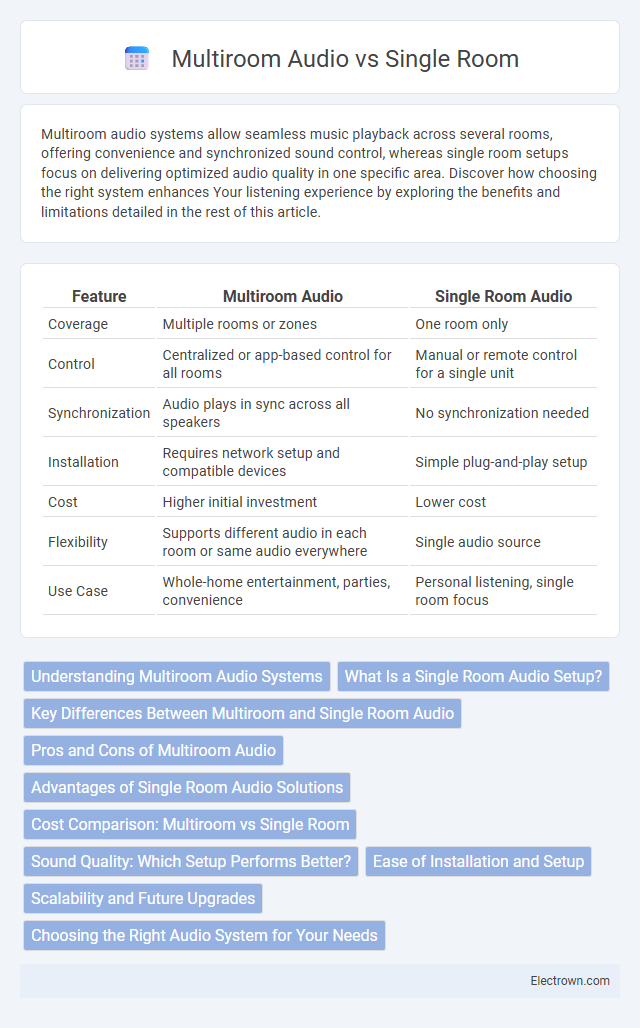Multiroom audio systems allow seamless music playback across several rooms, offering convenience and synchronized sound control, whereas single room setups focus on delivering optimized audio quality in one specific area. Discover how choosing the right system enhances Your listening experience by exploring the benefits and limitations detailed in the rest of this article.
Table of Comparison
| Feature | Multiroom Audio | Single Room Audio |
|---|---|---|
| Coverage | Multiple rooms or zones | One room only |
| Control | Centralized or app-based control for all rooms | Manual or remote control for a single unit |
| Synchronization | Audio plays in sync across all speakers | No synchronization needed |
| Installation | Requires network setup and compatible devices | Simple plug-and-play setup |
| Cost | Higher initial investment | Lower cost |
| Flexibility | Supports different audio in each room or same audio everywhere | Single audio source |
| Use Case | Whole-home entertainment, parties, convenience | Personal listening, single room focus |
Understanding Multiroom Audio Systems
Multiroom audio systems allow seamless streaming of music across multiple rooms using Wi-Fi or wired connections, providing synchronized or independent playback tailored to your preferences. Unlike single room setups that limit audio to one space, multiroom systems offer enhanced flexibility and control through apps or voice assistants. Choosing a multiroom audio system elevates your home entertainment by delivering high-quality sound throughout your entire living area.
What Is a Single Room Audio Setup?
A single room audio setup delivers high-quality sound specifically tailored for one room, ensuring clear and immersive audio without interference from multiple devices. This system simplifies control and installation, making it ideal for focused listening areas like living rooms or bedrooms. Your audio experience benefits from optimized speaker placement and acoustics designed to maximize sound performance in a defined space.
Key Differences Between Multiroom and Single Room Audio
Multiroom audio systems allow you to stream music simultaneously across multiple rooms, offering synchronized playback or unique tracks in each space, while single room audio focuses on delivering high-quality sound in one area only. Multiroom setups typically rely on wireless connections and smart technology integration, providing greater flexibility and control via apps or voice commands. Single room audio often emphasizes superior acoustics and speaker placement tailored to the specific room's size and layout, enhancing sound clarity and depth for that environment.
Pros and Cons of Multiroom Audio
Multiroom audio systems enable synchronized music playback throughout multiple rooms, enhancing convenience and immersive listening experiences in your home. These systems offer scalability, control via apps or voice assistants, and seamless integration with smart home devices, but they may involve higher costs, complex setup, and potential network issues. Single-room setups provide straightforward, budget-friendly solutions with focused sound quality but lack the versatility and convenience of whole-home audio coverage.
Advantages of Single Room Audio Solutions
Single room audio solutions offer precise sound control tailored to a specific space, ensuring optimal audio quality without interference from other areas. These systems are typically more affordable and easier to install, making them ideal for users seeking a straightforward setup with minimal complexity. Your experience benefits from focused audio performance and simpler management compared to multiroom configurations.
Cost Comparison: Multiroom vs Single Room
Multiroom audio systems typically involve higher upfront costs due to the need for multiple speakers, wireless hubs, and compatible devices across different rooms, whereas single room setups require only one speaker or sound system, making them more budget-friendly initially. Maintenance and expansion expenses also tend to be greater for multiroom systems since you may need to update or replace multiple components, while a single room audio system incurs lower ongoing costs. Your choice should balance the convenience of multiroom coverage against the cost efficiency of a single room audio solution.
Sound Quality: Which Setup Performs Better?
Multiroom audio systems often face minor sound quality compromises due to wireless transmission and network interference, whereas single-room setups typically provide clearer, more consistent audio with higher fidelity. Your single-room audio system benefits from direct connections or fewer wireless constraints, delivering better sound precision and minimal latency. However, advanced multiroom systems with high-quality components can rival single-room sound performance when properly configured.
Ease of Installation and Setup
Multiroom audio systems offer the advantage of centralized control, allowing you to manage multiple speakers across different rooms through a single app or device, making initial setup streamlined despite the complexity. Single room audio systems typically require less wiring and fewer configuration steps, resulting in quicker installation but limited scalability. Choosing between the two depends on whether you prioritize broad coverage with more involved setup or simplicity confined to one space.
Scalability and Future Upgrades
Multiroom audio systems offer unmatched scalability, allowing you to easily add speakers and zones throughout your home as your needs evolve. Unlike single-room setups, which are limited to fixed coverage, multiroom solutions support seamless integration of new devices and advanced features through Wi-Fi or mesh networks. Future upgrades become more efficient with multiroom systems, ensuring your audio experience can expand without requiring a complete overhaul.
Choosing the Right Audio System for Your Needs
Multiroom audio systems provide seamless music playback across multiple rooms with synchronized sound, offering flexibility and control through smartphone apps, while single-room setups focus on delivering high-quality audio in a specific space. Consider your living environment, how you engage with music, and desired coverage to determine if you need multiroom integration for whole-home audio or superior sound performance in one location. Your choice should balance convenience, audio quality, and budget to fit your lifestyle and listening preferences.
Multiroom Audio vs Single Room Infographic

 electrown.com
electrown.com